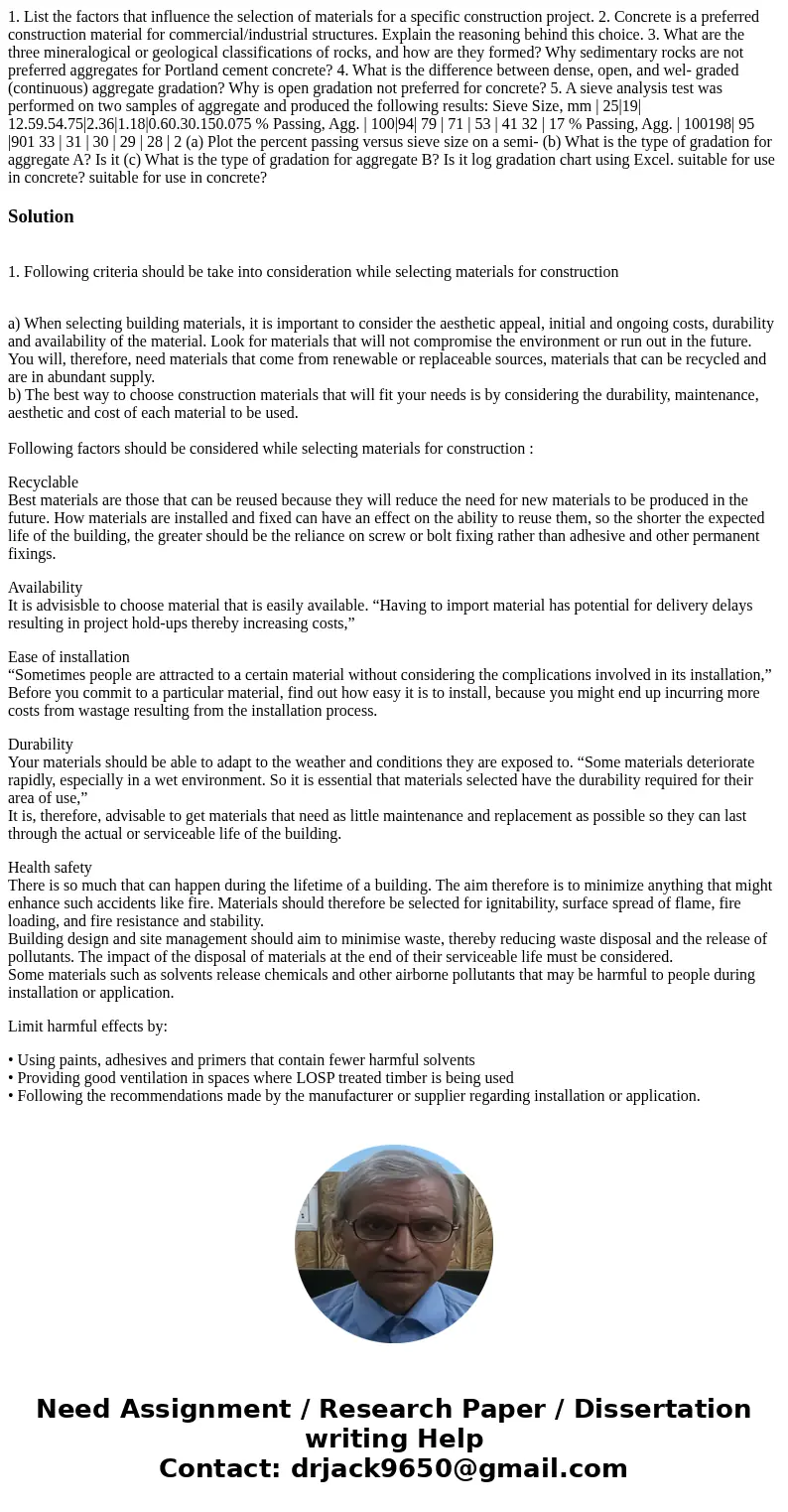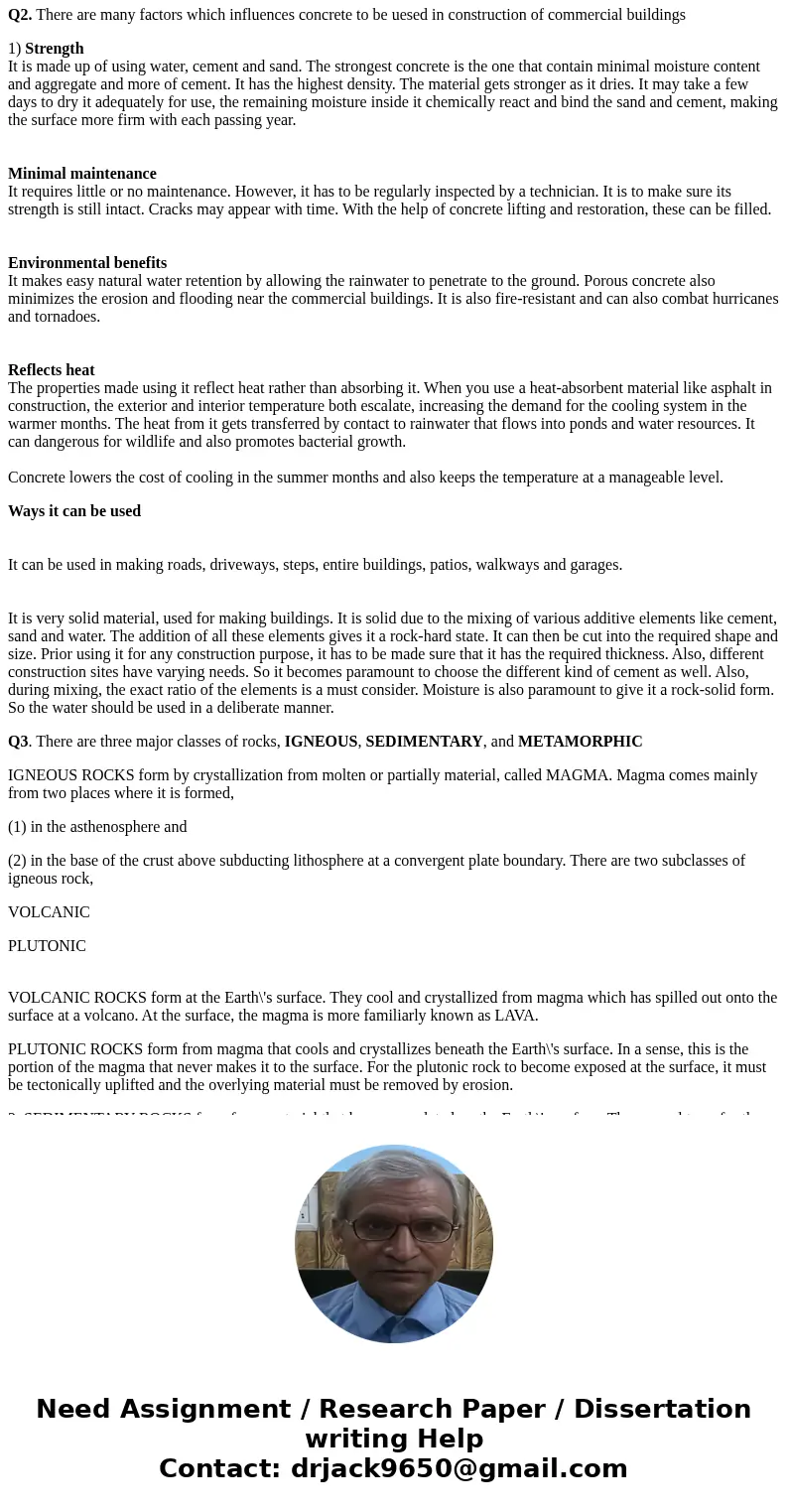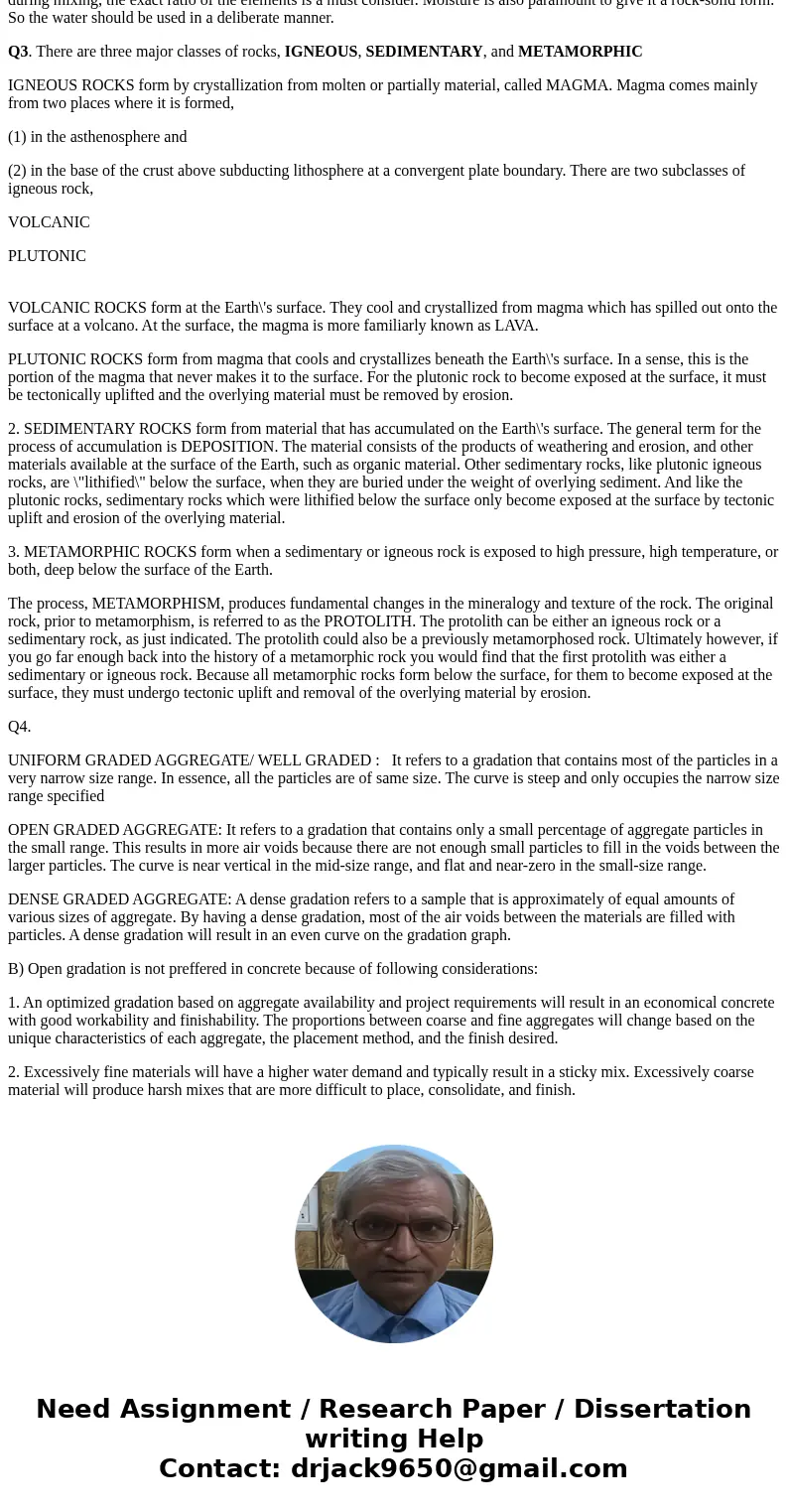1 List the factors that influence the selection of materials
Solution
1. Following criteria should be take into consideration while selecting materials for construction
a) When selecting building materials, it is important to consider the aesthetic appeal, initial and ongoing costs, durability and availability of the material. Look for materials that will not compromise the environment or run out in the future.
You will, therefore, need materials that come from renewable or replaceable sources, materials that can be recycled and are in abundant supply.
b) The best way to choose construction materials that will fit your needs is by considering the durability, maintenance, aesthetic and cost of each material to be used.
Following factors should be considered while selecting materials for construction :
Recyclable
Best materials are those that can be reused because they will reduce the need for new materials to be produced in the future. How materials are installed and fixed can have an effect on the ability to reuse them, so the shorter the expected life of the building, the greater should be the reliance on screw or bolt fixing rather than adhesive and other permanent fixings.
Availability
It is advisisble to choose material that is easily available. “Having to import material has potential for delivery delays resulting in project hold-ups thereby increasing costs,”
Ease of installation
“Sometimes people are attracted to a certain material without considering the complications involved in its installation,” Before you commit to a particular material, find out how easy it is to install, because you might end up incurring more costs from wastage resulting from the installation process.
Durability
Your materials should be able to adapt to the weather and conditions they are exposed to. “Some materials deteriorate rapidly, especially in a wet environment. So it is essential that materials selected have the durability required for their area of use,”
It is, therefore, advisable to get materials that need as little maintenance and replacement as possible so they can last through the actual or serviceable life of the building.
Health safety
There is so much that can happen during the lifetime of a building. The aim therefore is to minimize anything that might enhance such accidents like fire. Materials should therefore be selected for ignitability, surface spread of flame, fire loading, and fire resistance and stability.
Building design and site management should aim to minimise waste, thereby reducing waste disposal and the release of pollutants. The impact of the disposal of materials at the end of their serviceable life must be considered.
Some materials such as solvents release chemicals and other airborne pollutants that may be harmful to people during installation or application.
Limit harmful effects by:
• Using paints, adhesives and primers that contain fewer harmful solvents
• Providing good ventilation in spaces where LOSP treated timber is being used
• Following the recommendations made by the manufacturer or supplier regarding installation or application.
Q2. There are many factors which influences concrete to be uesed in construction of commercial buildings
1) Strength
It is made up of using water, cement and sand. The strongest concrete is the one that contain minimal moisture content and aggregate and more of cement. It has the highest density. The material gets stronger as it dries. It may take a few days to dry it adequately for use, the remaining moisture inside it chemically react and bind the sand and cement, making the surface more firm with each passing year.
Minimal maintenance
It requires little or no maintenance. However, it has to be regularly inspected by a technician. It is to make sure its strength is still intact. Cracks may appear with time. With the help of concrete lifting and restoration, these can be filled.
Environmental benefits
It makes easy natural water retention by allowing the rainwater to penetrate to the ground. Porous concrete also minimizes the erosion and flooding near the commercial buildings. It is also fire-resistant and can also combat hurricanes and tornadoes.
Reflects heat
The properties made using it reflect heat rather than absorbing it. When you use a heat-absorbent material like asphalt in construction, the exterior and interior temperature both escalate, increasing the demand for the cooling system in the warmer months. The heat from it gets transferred by contact to rainwater that flows into ponds and water resources. It can dangerous for wildlife and also promotes bacterial growth.
Concrete lowers the cost of cooling in the summer months and also keeps the temperature at a manageable level.
Ways it can be used
It can be used in making roads, driveways, steps, entire buildings, patios, walkways and garages.
It is very solid material, used for making buildings. It is solid due to the mixing of various additive elements like cement, sand and water. The addition of all these elements gives it a rock-hard state. It can then be cut into the required shape and size. Prior using it for any construction purpose, it has to be made sure that it has the required thickness. Also, different construction sites have varying needs. So it becomes paramount to choose the different kind of cement as well. Also, during mixing, the exact ratio of the elements is a must consider. Moisture is also paramount to give it a rock-solid form. So the water should be used in a deliberate manner.
Q3. There are three major classes of rocks, IGNEOUS, SEDIMENTARY, and METAMORPHIC
IGNEOUS ROCKS form by crystallization from molten or partially material, called MAGMA. Magma comes mainly from two places where it is formed,
(1) in the asthenosphere and
(2) in the base of the crust above subducting lithosphere at a convergent plate boundary. There are two subclasses of igneous rock,
VOLCANIC
PLUTONIC
VOLCANIC ROCKS form at the Earth\'s surface. They cool and crystallized from magma which has spilled out onto the surface at a volcano. At the surface, the magma is more familiarly known as LAVA.
PLUTONIC ROCKS form from magma that cools and crystallizes beneath the Earth\'s surface. In a sense, this is the portion of the magma that never makes it to the surface. For the plutonic rock to become exposed at the surface, it must be tectonically uplifted and the overlying material must be removed by erosion.
2. SEDIMENTARY ROCKS form from material that has accumulated on the Earth\'s surface. The general term for the process of accumulation is DEPOSITION. The material consists of the products of weathering and erosion, and other materials available at the surface of the Earth, such as organic material. Other sedimentary rocks, like plutonic igneous rocks, are \"lithified\" below the surface, when they are buried under the weight of overlying sediment. And like the plutonic rocks, sedimentary rocks which were lithified below the surface only become exposed at the surface by tectonic uplift and erosion of the overlying material.
3. METAMORPHIC ROCKS form when a sedimentary or igneous rock is exposed to high pressure, high temperature, or both, deep below the surface of the Earth.
The process, METAMORPHISM, produces fundamental changes in the mineralogy and texture of the rock. The original rock, prior to metamorphism, is referred to as the PROTOLITH. The protolith can be either an igneous rock or a sedimentary rock, as just indicated. The protolith could also be a previously metamorphosed rock. Ultimately however, if you go far enough back into the history of a metamorphic rock you would find that the first protolith was either a sedimentary or igneous rock. Because all metamorphic rocks form below the surface, for them to become exposed at the surface, they must undergo tectonic uplift and removal of the overlying material by erosion.
Q4.
UNIFORM GRADED AGGREGATE/ WELL GRADED : It refers to a gradation that contains most of the particles in a very narrow size range. In essence, all the particles are of same size. The curve is steep and only occupies the narrow size range specified
OPEN GRADED AGGREGATE: It refers to a gradation that contains only a small percentage of aggregate particles in the small range. This results in more air voids because there are not enough small particles to fill in the voids between the larger particles. The curve is near vertical in the mid-size range, and flat and near-zero in the small-size range.
DENSE GRADED AGGREGATE: A dense gradation refers to a sample that is approximately of equal amounts of various sizes of aggregate. By having a dense gradation, most of the air voids between the materials are filled with particles. A dense gradation will result in an even curve on the gradation graph.
B) Open gradation is not preffered in concrete because of following considerations:
1. An optimized gradation based on aggregate availability and project requirements will result in an economical concrete with good workability and finishability. The proportions between coarse and fine aggregates will change based on the unique characteristics of each aggregate, the placement method, and the finish desired.
2. Excessively fine materials will have a higher water demand and typically result in a sticky mix. Excessively coarse material will produce harsh mixes that are more difficult to place, consolidate, and finish.



 Homework Sourse
Homework Sourse